|
Avg. Price: $6 (BD$)
Availability: Very hard
to find in Barbadian pet shops
Species/genus: Pelvicachromis
pulcher.
Formerly Pelmatochromis pulcher & Pelmatochromis kribensis
Common Name(s): Kribensis,
Niger Cichlid, Purple Cichlid
Origin: Nigeria
Water Conditions: Ph:
6.5 to 7.5; Temp: 75 - 81°F (24 - 27°C) Hardness:
Soft to Hard Water
Temperament: Territorial.
Active & quite aggressive at breeding time. Can be peaceful
when not breeding.
Adult Size: 3-4 inches.
Water Region: Prefers
the Bottom & Middle regions of the aquarium.
Feeding: Omnivorous. Kribensis
will readily accept all types of live & prepared foods. Can
be fed flakes, spirulina, spinach, brine shrimp, freeze-dried
foods, mosquito larvae etc. Kribensis should be given a varied
assortment of foods. They relish live foods.
Sexual Differences: Difficult
to distinguished in juveniles. Males have a pointed tail
fin (caudal fin), while a female's is more rounded. Males
also have a pointed dorsal fin (the fin on its back) with
colour extending to the tip. It is not unusual to see black
spots of the males tail fin. Females usually have a rounded
dorsal fin without colour extending to the tip. Females are
smaller, with more rounded bodies. Females are also more colourful
with brighter red/purple bellies than the males.
Male
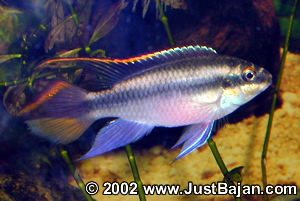
These two below have
formed a pair
The female is above the male
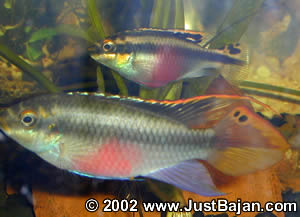
Breeding: Type: Egglayer.
Difficulty: Very Easy.
Kribensis (Kribs) are pair forming cichlids. Once a pair
has been established, they will breed readily. All they need
is a cave-like structure to breed in. Kribs are hidden brooders
and will not breed out in the open like some larger cichlids.
Overturn plant pots, driftwood, rock structures, coconut shells
and even PVC pipe make good hiding places for breeding. When
using dry coconut shells (or half shells), clean it thoroughly
and make a small entry hole, about 1 ½ to 2 inches, for the
fish to enter. When creating a stacked rock structure, make
certain that it is sturdy and will not collapse on your fish.
You can use aquarium silicon to glue them together. The water's
pH does seem to play a critical role when breeding. An alkaline
pH seems to produce predominately male offspring, while an
acid pH produces predominately females. Neutral water produces
a more balanced sex ratio.
The female is usually first to initiate courtship. She will
pair off with the strongest available male in the group. The
female will show off her bright red belly to the male and
often curl and vibrate her body in front of him. By swimming
upside-down, the female will deposit from between 50 to 300
eggs on the inner roof of the nest (though this is not always
the case). Kribensis are good parents. The female guards the
eggs and young while the male defends the territory. They
become extremely aggressive at this time and will even attack
fish larger than themselves. If you notice that your other
fish are restricted to a corner in the tank, that's a good
sign that your Kribensis are spawning. It is important to
have other fish in the tank for the parents to chase (know
as dither fish or target fish), otherwise the Kribs may take
out their aggression on each other. Good dither fish are fast
swimmers such barbs and tetras. Rosy Barbs make good dither
fish since they are usually too fast for the Kribs to catch.
The eggs hatch between 3 to 8 days. The parent may move the
fry to different locations by caring them in their mouths.
The fry are free swimming in about 5 to 10 days. Once fry
are free swimming, they can be fed finely crush flakes, and
newly hatch brine shrimp. If the tank is mature, there should
be enough organic matter for the fry to eat. The parents also
assist in feeding the young by spitting food to the fry. The
parents will gather the fry into a school and lead them on
excursions around the tank. Sometimes one parent may want
to take sole care of the fry and will attack the other parent
to keep it away. If this happens you should separate one of
them before they kill or injure each other. If possible, do
not remove the fry from the tank until the parents are ready
to breed again. Removing the fry too early may result in domestic
violence if the male is ready for some loving and the female
is not.
Minimum Tank Size: 20
gallons (24 inches long) for a single breeding pair
Tankmates: Mix with other
dwarf cichlids or similarly sized fish. Barbs and tetras are
good tankmates. Avoid slow moving fish such as Angelfish and
Gouramis. Guppies are a delicacy. Kribensis may also nip at
fish with long fins. If the tank is small, avoid tank mates
that are bottom dwellers that may compete for space and territory.
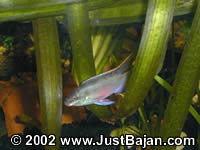 Special
Requirements: Should be kept in a well-planted
tank with lots of hiding places. Like many other cichlids,
Kribensis may remain in hiding if there aren't other braver
fish swimming out in the open. Therefore keep them with some
other active fish that always swim in the open. Kribensis
are river fish, so the water must be kept clean. Special
Requirements: Should be kept in a well-planted
tank with lots of hiding places. Like many other cichlids,
Kribensis may remain in hiding if there aren't other braver
fish swimming out in the open. Therefore keep them with some
other active fish that always swim in the open. Kribensis
are river fish, so the water must be kept clean.
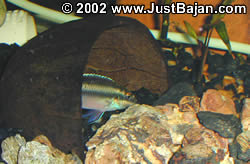
Provide lots of hiding places
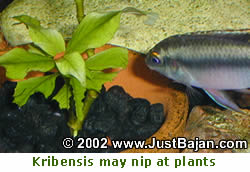 Comments: The Kribensis is a very hardy
fish and is not very demanding on water parameters. They can
survive in soft or hard water, and fresh and even slightly
brackish (salty) water. They are sometimes recommended for
first time cichlid owners. They will occasional nip at plants
and can be offered vegetable matter such as spinach (soften
the spinach in warm water). Kribensis are a joy to watch.
They can change colour in an instant, especially when you
feed them something they like. The way they swim is also quite
fascinating. They are fast swimmers and can stop in a snap,
swim backwards and even sideways. When they fight (or face
off) they will sometimes angle they bodies downwards, flare
there fins to look bigger, and drift towards there opponent.
Although they are small, remember that they can be quite aggressive,
so choose their tank mates with care. Kribensis have an approximate
lifespan of 5 years.
Comments: The Kribensis is a very hardy
fish and is not very demanding on water parameters. They can
survive in soft or hard water, and fresh and even slightly
brackish (salty) water. They are sometimes recommended for
first time cichlid owners. They will occasional nip at plants
and can be offered vegetable matter such as spinach (soften
the spinach in warm water). Kribensis are a joy to watch.
They can change colour in an instant, especially when you
feed them something they like. The way they swim is also quite
fascinating. They are fast swimmers and can stop in a snap,
swim backwards and even sideways. When they fight (or face
off) they will sometimes angle they bodies downwards, flare
there fins to look bigger, and drift towards there opponent.
Although they are small, remember that they can be quite aggressive,
so choose their tank mates with care. Kribensis have an approximate
lifespan of 5 years.
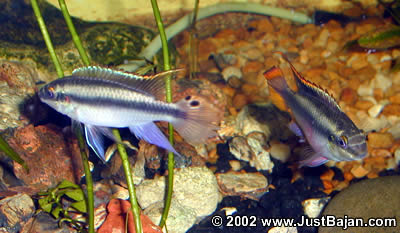
The male on the left flares his fins
when another male approaches
|



